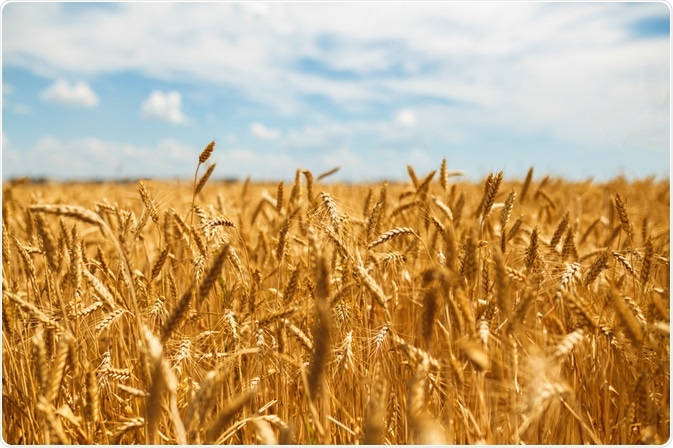Wheat is vitally important for human nutrition, globally, it is the most widely grown crop, accounting for roughly 20% of our daily protein intake and food calories. After rice, wheat is considered to be the most important food crop for people in the developing world.

Image Credit: maxbelchenko/Shutterstock.com
As the human population continues to increase as does the demand for food. This, coupled with the increasingly limited farming space due to the growing population and continuing urbanization of the globe, has resulted in a need to innovate new farming methods that can grow greater crop yields in smaller spaces.
The promise of vertical farming
One proposed solution to our increasingly limited farming space is vertical farming. Indoor vertical farms have proven to be a viable option for growing crops in yields hundreds of times higher than would be possible in the same space using conventional farming due to the utilization of vertically stacked layers, taking advantage of vertical space.
Currently, most research has focused on how vertical farming is beneficial for growing greens, such as lettuce, kale, and microgreens. Now, recent research is revealing its success at growing other crops, such as wheat. A recent study conducted by a group of researchers at the University of Florida demonstrated that it is possible to grow exponentially more wheat using vertical farming methods than can be grown with conventional farming methods using the same space.
To ensure the success of vertical farming in growing healthy crop yields that food producers can rely on, scientists must understand exactly how factors that are controlled under vertical farming conditions. For example, lighting, water, nutrients, humidity, temperature, are all factors that affect crop growth that do not occur naturally within vertical farming structures and must be controlled for.
Recent research has demonstrated how light affects wheat plants, which will be significant for the future of vertical farming and ensuring food security as populations continue to increase.
Controlling the light source to enhance wheat growth
Several light factors can impact the growth and quality of plants, such as the light quality, light intensity, photoperiod, and the day/night cycle. These factors have been explored in the growing of wheat, with researchers determining which conditions are most favorable for greater crop yields and crop quality.
Scientists in Japan investigated how the developmental rate was affected by exposure to various light qualities. The researchers placed wheat crops under continuous light of a total of eight different qualities obtained from varying combinations of four different colors of fluorescent lamps (blue, purplish-red, ultraviolet-A, and white). Other factors were maintained to be the same across groups.
The results showed that the length between the events of seeding and heading varied greatly depending on the quality of the light the crops were exposed to. White light proved to be the best color for promoting the speed between seeding and heading. Also, the scientists found that the developmental rate was correlated with the ratio of energy in the green light, red light, and whole spectral range. The findings indicate that red and green lights may be important for regulating the developmental rate of the wheat crop.
Further to this, researchers have also discovered that light intensity is important for crop yield, biomass, and the number of tillers. Recent studies have shown that higher light intensities are correlated with greater numbers of tillers, biomass, and yield in wheat crops. Conversely, exposure to lower light intensities, such as blue, green, and far-red light, had an antagonist effect during the stem elongation period.
The results of these studies highlight the potential to control the yield and quality of wheat crops when using artificial lighting, such as when using the vertical farming method. Research is demonstrating that farmers can manipulate the outcomes of crop growth by setting favorable lighting conditions for the plants.
Finally, studies have also revealed that the day/night cycle is also highly impactful to crop yield. Results have shown that increasing day length and reducing night length is correlated with increased yield in wheat plants, as well as a greater leaf area, and a greater total number of leaves and tillers.
The future of wheat farming
Overall, research is helping farmers understand how to manipulate lighting conditions to enhance the quality and yield of wheat plants. The future of agriculture is likely going to heavily rely on newly developing methods, such as vertical farming. With mounting evidence demonstrating how farmers can maximize wheat crop yield and quality through lighting, vertical farming looks to be a strong option for overcoming the limitations of conventional farming techniques, which rely on large spaces.
Research into the effects of manipulating other factors, such as water, temperature, humidity, and soil nutrients will likely add to the data we have on lighting to allow for the precision control of wheat crop growth.
What is organic farming?
Sources:
- Asseng, S., Guarin, J., Raman, M., Monje, O., Kiss, G., Despommier, D., Meggers, F., and Gauthier, P., 2020. Wheat yield potential in controlled-environment vertical farms. Proceedings of the National Academy of Sciences, 117(32), pp.19131-19135. https://www.pnas.org/content/117/32/19131
- Kasajima, S., Inoue, N., Mahmud, R., Fujita, K., and Kato, M., 2007. Effect of Light Quality on Developmental Rate of Wheat under Continuous Light at a Constant Temperature. Plant Production Science, 10(3), pp.286-291. https://www.tandfonline.com/doi/pdf/10.1626/pps.10.286
- Monostori, I., Heilmann, M., Kocsy, G., Rakszegi, M., Ahres, M., Altenbach, S., Szalai, G., Pál, M., Toldi, D., Simon-Sarkadi, L., Harnos, N., Galiba, G. and Darko, É., 2018. LED Lighting – Modification of Growth, Metabolism, Yield, and Flour Composition in Wheat by Spectral Quality and Intensity. Frontiers in Plant Science, 9. https://www.ncbi.nlm.nih.gov/pmc/articles/PMC5945875/
- Friend, D., Helson, V., and Fisher, J., 1967. Effect of day length on the growth of wheat. Canadian Journal of Botany, 45(1), pp.117-131. www.nrcresearchpress.com/.../b67-008?journalCode=cjb1#.X14zfi05Q1g
Further Reading
Last Updated: Oct 20, 2020